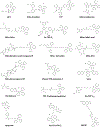Mitochondria as a Novel Target for Cancer Chemoprevention: Emergence of Mitochondrial-targeting Agents
- PMID: 33303695
- PMCID: PMC8137522
- DOI: 10.1158/1940-6207.CAPR-20-0425
Mitochondria as a Novel Target for Cancer Chemoprevention: Emergence of Mitochondrial-targeting Agents
Abstract
Cancer chemoprevention is the most effective approach to control cancer in the population. Despite significant progress, chemoprevention has not been widely adopted because agents that are safe tend to be less effective and those that are highly effective tend to be toxic. Thus, there is an urgent need to develop novel and effective chemopreventive agents, such as mitochondria-targeted agents, that can prevent cancer and prolong survival. Mitochondria, the central site for cellular energy production, have important functions in cell survival and death. Several studies have revealed a significant role for mitochondrial metabolism in promoting cancer development and progression, making mitochondria a promising new target for cancer prevention. Conjugating delocalized lipophilic cations, such as triphenylphosphonium cation (TPP+), to compounds of interest is an effective approach for mitochondrial targeting. The hyperpolarized tumor cell membrane and mitochondrial membrane potential allow for selective accumulation of TPP+ conjugates in tumor cell mitochondria versus those in normal cells. This could enhance direct killing of precancerous, dysplastic, and tumor cells while minimizing potential toxicities to normal cells.
©2020 American Association for Cancer Research.
Conflict of interest statement
Figures



Similar articles
-
Mitochondria-Targeted Triphenylphosphonium-Based Compounds: Syntheses, Mechanisms of Action, and Therapeutic and Diagnostic Applications.Chem Rev. 2017 Aug 9;117(15):10043-10120. doi: 10.1021/acs.chemrev.7b00042. Epub 2017 Jun 27. Chem Rev. 2017. PMID: 28654243 Free PMC article. Review.
-
TPP-based conjugates: potential targeting ligands.Drug Discov Today. 2024 Jun;29(6):103983. doi: 10.1016/j.drudis.2024.103983. Epub 2024 Apr 18. Drug Discov Today. 2024. PMID: 38641237 Review.
-
A review of the basics of mitochondrial bioenergetics, metabolism, and related signaling pathways in cancer cells: Therapeutic targeting of tumor mitochondria with lipophilic cationic compounds.Redox Biol. 2018 Apr;14:316-327. doi: 10.1016/j.redox.2017.09.020. Epub 2017 Sep 29. Redox Biol. 2018. PMID: 29017115 Free PMC article. Review.
-
Triphenylphosphonium Cations of the Diterpenoid Isosteviol: Synthesis and Antimitotic Activity in a Sea Urchin Embryo Model.J Nat Prod. 2015 Jun 26;78(6):1300-8. doi: 10.1021/acs.jnatprod.5b00124. Epub 2015 Jun 4. J Nat Prod. 2015. PMID: 26042548
-
Application Prospects of Triphenylphosphine-Based Mitochondria-Targeted Cancer Therapy.Cancers (Basel). 2023 Jan 21;15(3):666. doi: 10.3390/cancers15030666. Cancers (Basel). 2023. PMID: 36765624 Free PMC article. Review.
Cited by
-
Targeting Mitochondria with ClpP Agonists as a Novel Therapeutic Opportunity in Breast Cancer.Cancers (Basel). 2023 Mar 23;15(7):1936. doi: 10.3390/cancers15071936. Cancers (Basel). 2023. PMID: 37046596 Free PMC article. Review.
-
PTPMT1 inhibition induces apoptosis and growth arrest of human SCLC cells by disrupting mitochondrial metabolism.Transl Cancer Res. 2024 Dec 31;13(12):6956-6969. doi: 10.21037/tcr-2024-2379. Epub 2024 Dec 27. Transl Cancer Res. 2024. PMID: 39816544 Free PMC article.
-
Novel NIR fluorescent probe IR-546 inhibits melanoma through the AKT/GSK3β/β-catenin pathway.Mol Med. 2025 Jun 10;31(1):226. doi: 10.1186/s10020-025-01289-0. Mol Med. 2025. PMID: 40495167 Free PMC article.
-
Metabolic Response to the Mitochondrial Toxin 1-Methyl-4-phenylpyridinium (MPP+) in LDH-A/B Double-knockout LS174T Colon Cancer Cells.Cancer Genomics Proteomics. 2021 May-Jun;18(3 Suppl):385-405. doi: 10.21873/cgp.20267. Cancer Genomics Proteomics. 2021. PMID: 33994363 Free PMC article.
-
Recent Updates on the Efficacy of Mitocans in Photo/Radio-therapy for Targeting Metabolism in Chemo/Radio-resistant Cancers: Nanotherapeutics.Curr Med Chem. 2025;32(11):2156-2182. doi: 10.2174/0109298673259347231019121757. Curr Med Chem. 2025. PMID: 38018190 Review.
References
-
- Warburg O The Metabolism of Carcinoma Cells. The Journal of Cancer Research. 1925;9(1):148.
-
- Racker E. Bioenergetics and the Problem of Tumor Growth: An understanding of the mechanism of the generation and control of biological energy may shed light on the problem of tumor growth. American Scientist. 1972;60(1):56–63. - PubMed
Publication types
MeSH terms
Substances
Grants and funding
LinkOut - more resources
Full Text Sources
Medical

